Super Bowl XI - Oakland Raiders vs Minnesota Vikings: Pregame
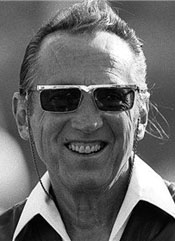
Al Davis

John Madden
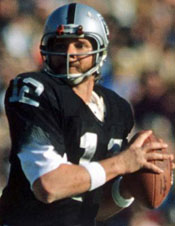
Ken Stabler
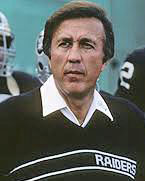
Tom Flores
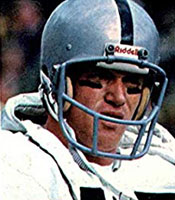
Dave Casper
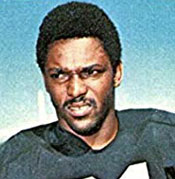
Cliff Branch
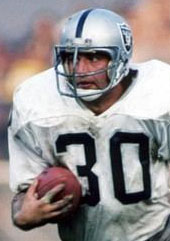
Mark van Eeghen
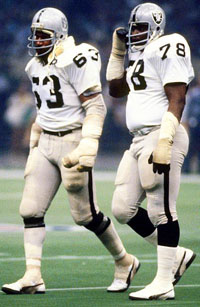
Gene Upshaw and Art Shell
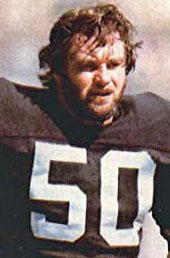
Dave Dalby
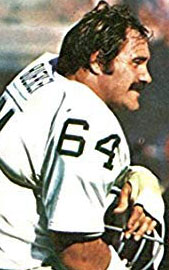
George Buehler
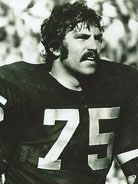
John Vella

Ted Hendricks
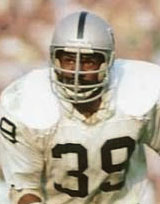
Willie Hall
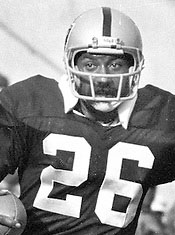
Skip Thomas
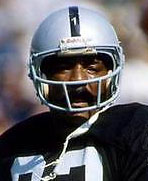
Jack Tatum
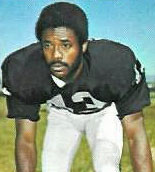
George Atkinson
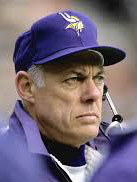
Bud Grant
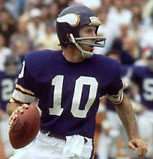
Fran Tarkenton

Jim Marshall
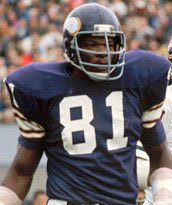
Carl Eller
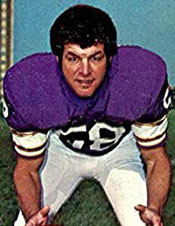
Wally Hilgenberg
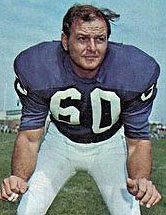
Roy Winston

Paul Krause
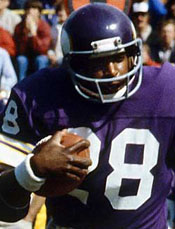
Ahmad Rashad

Sammy White
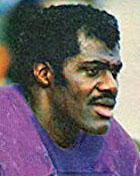
Alan Page

Fred Biletnikoff in his loose-fitting uniform.

John Robinson
|
As the nation celebrated its bicentennial, the NFL celebrated by adding two expansion teams.
- The Tampa Bay Buccaneers joined the AFC West while the Seattle Seahawks began play in the NFC West.
- So both conferences had 14 teams, five in the East and West and four in the Central.
- The Bucs under former USC coach John McKay went 0-14 while the Seahawks, led by Jack Patera, managed to win two games.
Whereas Super Bowls IX and X had finally brought championships to Art Rooney, the revered owner of the Steelers, the 1976 NFL season finally put renegade owner Al Davis of the Raiders in position to win the title for the first time.
- Davis's career in Oakland began as the Raiders' head coach in 1963. Acting as de factor General Manager, Al cleaned house both in the front office and on the team.
- With an eye for talent and an offensive mind formed as an assistant to the Chargers' Sid Gillman, Davis improved the Raiders from 1-13 to 10-4 in just one year.
After 5-7-2 and 8-5-1 seasons, Al was chosen by the AFL owners as their new commissioner in the spring of 1966.
- Armed with a new TV contract with NBC, Davis, the street fighter from Brooklyn, embarked on an audacious plan to force the NFL to merge with the AFL. Building on the fact that the NFL had been forced to pay its high profile draft choices much more money to keep them from signing with the AFL, Davis urged his teams to sign NFL stars whose contracts would expire after the upcoming season, such as QBs Roman Gabriel of the Rams and John Brodie of the 49ers.
- The strategy paid dividends immediately. The NFL agreed to a merger June 8, 1966 with all eight AFL teams being absorbed into the older league for the 1970 season.
- Davis was bitterly disappointed when the AFL owners supported NFL Commissioner Pete Rozelle as the head of the merged league. So he resigned head of the AFL immediately and returned to the Raiders rather than wait until the 1970 merger.
- Along with two partners, Al took over ownership of the Raiders and resumed his position as General Manager. The Raiders won the AFL championship in 1967 under Coach John Rauch, losing to Lombardi's Packers in Super Bowl II.
In 1969, Davis promoted 32-year-old LBs coach John Madden to the head position, triggering a decade of success that included seven AFC West championships and the most wins of any team over that period.
- Unfortunately, in Madden's first seven years, the Raiders lost in the AFL or AFC Championship Game five times, once to the Colts, once to the Dolphins, and three times to the Steelers. Madden had compiled a better career winning percentage than Chuck Noll, Don Shula, or Tom Landry but still had to endure taunts of "can't win the big one."
- 1976 finally brought a breakthrough. Because their 13-1 record topped the AFC, the Raiders hosted the Steelers in the title game and won 24-7 to qualify for their second Super Bowl. However, skeptics pointed out that Pittsburgh played without their two starting RBs, Franco Harris and Rocky Bleier.
The Raiders had neither the AFC's best offense (#3) nor the best defense (#10). But they managed to win all but one game with their big play capability on both sides of the ball.
- QB Ken "Snake" Stabler, a fourth-year starter, had his best year as a pro, leading the NFL in completion % (66.7) and TDs (27). Receivers coach Tom Flores recalled: "Kenny did not have a strong arm, but he knew that he had to throw the ball early and throw it hard. He was so accurate. He was perfect for the change of times ... When they went to all the different zones, with Snake's quick release, that was his strength."
Stabler suffered bruised ribs in the AFC title game but long whirlpool baths allowed him to participate in the light workouts the next week.
- The former Alabama QB had three favorite receivers: TE Dave Casper (53 receptions for 691y), Cliff Branch (46/1111), and Fred Biletnikoff (43/551).
Biletnikoff's pursuit of perfection was relentless. He would stage his own post-practice sessions with his own bag of balls. He would recruit Stabler to throw to him - 25 corner routes, 25 curl-ins. When Kenny got tired, Fred would find someone else to throw to him. The WR would also jump rope and use a boxer's speed bag, which he believed would keep both hands in sync. His footwork was as precise as a ballet dancer's.
- Workhorse FB Mark Van Eeghen gained 1,012y on 233 attempt while Clarence Davis from the USC TB assembly line gained about half that number (516y).
- The key to the Oakland offense was the offensive line:
--LT Art Shell (8-year veteran)
--LG Gene Upshaw (9)
--C Dave Dalby (4)
--RG George Buehler (7)
--RT John Vella (4)
Both Shell and Upshaw are in the Pro Football Hall of Fame. They formed as formidable a tackle-guard tandem as the NFL has ever seen. A basketball player in college, Shell had incredible footwork for a man his size.
Ron Wolf, a scout for the Raiders from 1963-1974, assessed the O-line he helped assemble this way: "That was a great Raiders' line. Dalby wasn't as good as Jim Otto [the Oakland Hall of Fame C from 1960-1974], but he was a very good player. Buehler was certainly not in the class of Upshaw, but he was squatty, square, a solid pro. John Vella was as good a pass protector as there was and a very good run blocker. He had a mean, nasty disposition. Shell was a great, great player, but John Vella was a Pro Bowl tackle who will never get his due."
Oakland's defense changed significantly when the coaching staff switched to the 3-4 alignment for the '76 season.
- The 3-4 was making inroads in the league as a way to combat the increasing use of spread passing attacks. Madden explained why he used the 3-4. "Ultimately, it comes down to who your people are. If your fourth LB is better than your fourth lineman, then the 3-4 is better for you."
- Free agent OLB Ted Hendricks had been signed in 1975. He proved to be worth the two first round draft picks paid to Green Bay under the Rozelle Rule. The Oakland staff installed the new defense in part to free Hendricks to concentrate entirely on the flank. Willie Hall became the fourth LB, playing inside of Ted.
S Jack Tatum recalled: "Not only did we get big up front when we went to the 3-4, but we got another great athlete on the field. Willie Hall was a great athlete who made great plays. It seemed like he made at least one in every game. When we played a four-man line, we had no place for him."
- An important addition for '76 was 6-8 270 lb LE John "Tooz" Matuszak, the first pick in the '73 NFL draft by Houston, who played on the opposite side from the 6-7 Hendricks, "The Mad Stork."
- The last piece to the defensive puzzle was another giant, 6-7 280 lb Dave Rowe, who played NT in the 3-4 scheme.
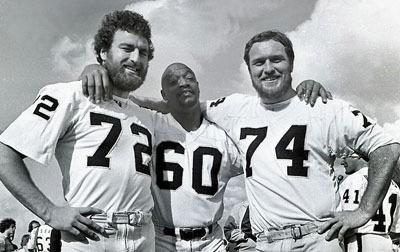
Raiders front three: John Matuszak, Otis Sistrunk, Dave Rowe
- The defense got steadily better as the season progressed as the players became more comfortable with the new alignment.
Matuszak hated the new alignment. "In the 3-4, what the linemen basically do is make things happen for the LBs." Houston NT Curly Culp explained his frustration this way. "We sacrifice our bodies so the LBs can make tackles. I guess we're the garbage collectors." The four LBs also got a chunk of the sacks that went to the D-linemen in the 4-3.
- While the nastiest defenders on most teams played in the trenches, it was different on the Raiders. As Stabler put it, "The meanest critters on the Raiders in the seventies were the defensive backs. They definitely got the attention of anyone who entered their territory."
--
LCB Skip Thomas loved his nickname, "Dr. Death," which he had painted on the doors of his white Corvette.
--
FS Jack Tatum was "The Assassin." Stabler said of him, "His footsteps broke up more passes than his hands did."
--
The SS George Atkinson didn't need a nickname although it could have been "The Hook" for the forearm he threw into a receiver's neck to bring him down. George bragged, "I treat receivers the way I would treat a burglar in my house. Don't nobody mess with my things."
--RCB Willie Brown, a future Hall of Famer, was the old man of the group at 36. Stabler: "In charge of all these rowdies, the man who kept them from going too far was defensive captain ... Willie Brown. He kept the others from killing." Brown was one of four Raiders - with Biletniknoff, Upshaw, and RB Pete Banaszak - who had played on the Super Bowl II team.
Kansas City coach Paul Wiggin said of the Oakland defenders: "They're not really bad fellows. It's just that they're trained to kill."
The Tooz had feuded with his previous coaches but found a home with Madden.
- Unlike other top coaches at the time - Don Shula, Tom Landry, Chuck Noll, and Bud Grant to name four - Madden was not a martinet. He didn't bother with nit-picky rules like dress codes. Be on time, practice hard, and play like hell, and Big John had no complaint.
Madden: "I was coaching at a time when you had to wear white shirts and ties. Well, you don't have to wear white shirts and ties. Facial hair? That has nothing to do with winning or losing."
RB Mark Van Eeghen: "Any rule or regulation on the Raiders had to do with nothing but winning. Otherwise it was not a regulation."
- Stabler: "Big John was tough, especially during practice. If plays weren't running smoothly, he would keep us out on the field until the offense was tuned like a racing engine. We just kept working until we got it right, with John standing there hollering, waving his hands in the air, and cussing. ... He was a good guy, the ideal coach for the renegade Raiders. Everybody liked John and got along well with him. I never heard one player cuss him seriously."
In the NFC, Bud Grant's 11-2-1 Minnesota Vikings garnered their fourth title in the last eight seasons to get another chance to win their first Super Bowl.
Based on conversations at the Pro Bowl with players from other Super Bowl teams, Madden devised a plan to shepherd his squad through the two weeks leading up to the Super Bowl. With hardly anyone on his team with Super Bowl experience, John wanted to dispose of all distractions.
- Years later, Madden recalled: "I always figured that the team with the fewest complaints always won the game. The team that was complaining about extra tickets, extra people, the practice facility, usually lost. So the first week, I said, 'We're going to get everything out of the way.' I got all the players' tickets right off the bat and told them to get rid of them before we flew down to L.A. ... Other teams complain, 'You take wives down; how about if you don't have a wife? A girlfriend? A mother?' Those things could become issues. So I made sure everyone had an extra room for whoever they wanted. Then I made sure everyone had an extra seat on the airplane. I wanted all the extracurriculars out of the way."
- The coach also told his men to embrace the hoopla and even enjoy it. Trying to reduce the pressure, he held loose practices the first week. "We played touch football one day," recalled Dave Rowe.
- Madden: "We did some football work that first week, but we watched a lot of film so we could get acquainted with what they looked like. If you practice the game plan the first week, if you have something done early, you just have to go over it again, and the next thing, I figured boredom would set in. And my team wasn't a team that handled boredom well."
- John later explained: "Our game plan wasn't fancy or tricky. We just didn't want to be predictable. We wanted to run on passing downs, to pass on running downs, to run on running downs, to pass on passing down. We wanted not to bet into any regular pattern."
- The Raiders also made sure they gave the Vikings no bulletin board material. Flores: "We were always careful in how we approached it from a publicity standpoint. We didn't want to put out any fodder verbally."
- Aiding that approach was the fact that Al Davis was nowhere to be found in California. He was supposedly in Mobile scouting the Senior Bowl as he always did. When he finally joined the club, he kept a low profile. He told writer Dan Jenkins, "You know me. If I come around, I say something controversial, and the commissioner doesn't get the headlines."
Madden tried to make the week of the game like any other game week that season.
- No curfews Monday, Tuesday, or Wednesday night. Stabler and Biletnikoff, two bachelors who loved to party, enjoyed themselves those three nights, then settled down after that.
- No practice Monday. No two-a-day practices, no extra meetings. "We didn't change a thing," Rowe recalled. "Tuesday was going over the game plan, Wednesday was defense day, Thursday was offense day, Friday was short-yardage and goal-line, and Saturday was special teams, like it'd been all year."
- Madden: "Other than the press conferences, everything was a normal work week. No distractions. The only thing that's a distraction is if it's something that isn't planned. I had everything planned." Asked if he told the team, "You're about to play the biggest game of your life," John replied, "They knew that. That's the last thing I'd say."
Stabler: "Our workouts were all loose. The Super Bowl wasn't just another football game, but that's the way we practiced. Serious work got done, with a lot of laughing and grab-assing in between."
- The night before the game, Davis moved his team to a Hilton in downtown Los Angeles, which in those days was an urban wasteland. Even if players were tempted to hit the town, there was nowhere to go.
- The Raiders agreed that their coach's plan worked well. "John prepared us really well the week before the Super Bowl," said Otis Sistrunk. "When we got to Pasadena, it was more business than it was pleasure." Phil Villapiano agreed. "I give John Madden credit. He kept us together. He kept us grounded. He kept us focused. We knew we had to play our best game, and that meant everybody."
Sistrunk had not gone to college, having joined the Marines right out of high school. He began playing semipro football where a Raiders scout discovered him. Otis fitted in well with the Raiders. The game program listed his alma mater as "U.S. Mars" (U.S. Marines). Former NFL great Alex Karras, announcing a game for ABC, suggested Sistrun+k was from the "University of Mars."
- Flores remembered that the last offensive practice on Thursday was cut short. "Snake was dropping back and throwing, dropping back and throwing, and the ball never hit the ground. That's how sharp we were. Dozens of passes, and not one hit the ground. It was eerie. Finally John claps his hands and says, 'Okay, that's enough.' We were ready."
Art Shell recalled: "We were loose. The day before the game was a light day and some guys took a roll of tape and made a big ball out of it and started playing softball with the helmets. I remember looking at the sideline and Mr. Davis kept looking over as if to say, 'What are we doing? Are we crazy?'"
- The night before the game, Madden told Al Davis, "We're going to kill 'em. I just know we're going to kill 'em tomorrow." Al replied, "No, no, John, don't talk like that. Don't ever talk like that before a game. You know better than that."
The teams met the press in their home cities and in Los Angeles as required by the league office. Each day the week of the game, a caravan of buses and cars took the news media from Super Bowl headquarters in downtown Los Angeles to the Vikings workouts at Blair Field in Long Beach and the Raiders' practice at UC Irvine. Both teams were hampered by the rain that fell throughout the week.
- Tarkenton: "We want the whole world to know this time we're going to win the Super Bowl. There's an obsession with this team to win this game." While not garnering the amount of publicity that Joe Namath's boast before Super Bowl III did, Fran's remark was taken as a "guarantee" of victory. When asked his reaction, Madden replied, "I guess if both sides guarantee a victory, they've got to play the game."
- Grant praised the opposition. "The Raiders have the best personnel in football." He also dismissed questions about past history. "It doesn't bother me that we lost those other three games. It's not like a business failure. Remember, it's only a game. It also doesn't bother me that we're an underdog. That just makes for good copy all week. It doesn't have anything to do with what kind of game it's going to be." Bud speculated that the game might hinge on a special teams play. "I think when you have evenly-matched teams, many times the game revolves around a big play or a play involving the kicking department. Because the defenses are strong, you're going to have more punts, probably less chances for touchdowns, and more FG attempts. It becomes important how you kick and how you cover." He pointed out that a blocked FG attempt and a blocked punt were pivotal in the Vikings' 24-13 triumph over Los Angelesin the NFC championship clash.
- WR Ahmad Rashad was prepared to compete against the Raiders' vaunted secondary. "They pay a rough style of football, but the game is rough. Things like that you can't let get to you. I'm sure they can intimidate you if they start doing things like that. But I never think of anybody's territory. When I play, the field is mine."
- WR Sammy White saw the films of George Atkinson's hit on Steelers WR Lynn Swann in the AFC title game. "It was a real bad cheap shot. He should have been thrown out of the game. It was the most flagrant cheap shot I've seen all year. What the Raiders want you to do is to be ready to fight rather than play your own game. I'm aware that they probably will try to belt me, and I'm going to be mentally prepared. If you have it in the back of your head that they're going to be shooting cheap shots, you probably can survive any of them. But when the ball comes, there ain't nothing else in your mind except catching the ball, total concentration."
- Stabler echoed what his coach had been preaching: "I'm looking forward to the game, but I think it's possible to enjoy everything connected with the Super Bowl. The atmosphere should be exciting." He contrasted this feeling with what he went through the last three years. "I was home crying in my beer at this time, replaying games we'd lost a hundred times in my mind. I watched about half of last year's Super Bowl on television, and I didn't watch at all the two years before that because I was so depressed."
- Madden expressed confidence that his team would handle the hoopla. "We've been involved in a lot of big games over the yers, games surrounded by a lot of controversy. I don't know why the Super Bowl atmosphere should be a problem for this group." He added, "I can promise you there won't be any letdown. The Pittsburgh game is out of our minds. The Minnesota Vikings are the only thing on our minds right now."
- The Raiders who played in Super Bowl II agreed that this team was much more prepared to play. "We're more enthusiastic now," said Biletnikoff. "We were a little bit in awe when we played the first time. We'd never played Green Bay and just couldn't cope with it." Upshaw agreed. "We weren't mentally ready then. Now we're more mature. We have grown through adversity." Willie Brown chimed in, "I thought we were as good as Green Bay but that game got twisted around fast. Nobody knew what to expect. Now we all have the right attitude."
- Surprisingly, the only controversial remarks came from Vikings DT Alan Page, the future lawyer who was normally measured in his remarks. Asked about going up against Upshaw, the Notre Dame grad replied, "Gene's a great player, but he holds me a lot. He's such a great player he really shouldn't have to do that." When asked to respond, Upshaw retorted, "No offensive lineman likes to talk about holding - nor do defensive linemen like to talk about things like late hits or flying elbows."
- Page was also asked how he'd feel if the Vikings lost yet again. "It's a football game. To win will be nice, but to lose will not be the end of the world." No Raider expressed that attitude.
The search for stories got so bad that the topic of sex before the big game sparked midweek articles inspired by Joe Namath's revelation in his autobiography that he had "a bottle and a broad" the night before Super Bowl III. Some NFL coaches, including Vince Lombardi, Hank Stram, and George Allen, enforced the rule, "No Sex after Tuesday." But neither Grant nor Madden subscribed to that philosophy. "You've got to let the fellows follow their normal pattern of life. After all, they're not in the service," said the Vikings coach. "We are doing our best not to interfere with the players' regular habits," said Madden. Both teams allowed wives and girl friends to be flown to Los Angeles on Wednesday and stay at hotels near the teams' quarters. The only restrictions were the curfews - midnight Thursday and Friday and 11 PM Saturday.
Despite their better record in the superior conference, Oakland was only a 4-point favorite.
- Many oddsmakers, including the famous Jimmy the Greek, still had difficulty giving the AFC its due.
- The Raiders' inability to "win the big one" also factored into the odds.
Sid Hartman, longtime reporter for the Minneapolis StarTribune recalled: "The night before the game I roomed with Grant at the hotel. Bud ate about three gallons of ice cream that night. Bud liked ice cream. I knew Al Davis, the Oakland owner, real well from when he worked for Sid Gillman. I was the only media guy who could watch the Vikings practice, and Davis was bugging me for a scouting report. I told him, and I don’t know why I said it, that the Vikings think they can block a punt."
With kickoff set for 12:30 PST, Madden was terrified that his team wouldn't make it to the Rose Bowl on time.
- He called his childhood friend John Robinson, the USC coach, who warned him that the traffic on the Pasadena streets leading to the stadium would be heavy. So John hired two helicopters to lead his buses to the Rose Bowl.
Robinson had been an assistant on the Raiders the year before. The day he left to take the USC job, he made a prediction to his old pal. "Next year, I'm going to be in the Rose Bowl with SC, and you're going to be in the Super Bowl at the Rose Bowl with the Raiders. You wait and see." New Year's Day, USC had beaten Michigan in the Rose Bowl 14-6.
- But that still wasn't enough to stem his anxiety. At the team breakfast Sunday morning, he changed the departure from 10 AM to 9:15. "He was so worried that morning about getting there," recalled Banaszak, "he left guys back [at the hotel]. That morning you couldn't get a toothpick in his rear end with an air hammer."
- Four players were left behind: Clarence Davis, John Matuszak, Carl Garrett, and Hubie Ginn. Two took a cab while Matuszak and the fourth one got a ride with a fan who was dressed in a pirate costume with a sword. When the latecomers arrived at the stadium, they hid out from Madden in the locker room. But John sent an assistant to tell them, "It was my fault. Tell them no fine."
Van Eeghen recalled: "I didn't think I was nervous even Saturday night. I went to bed and the game still seemed light-years away. But the next morning I was very, very, very nervous and introspective as hell. At the team meal at the hotel, I put this game face on that must have looked so tight. I got on the bus taking us to the Rose Bowl and sat by myself and was staring out the window with that game face on. It must have looked like I lost my best friend. Jack Tatum came down the aisle and just started laughing at me. He shouted, "What's the matter with you?" He just broke it for me.
The teams went through their usual routines in the locker rooms. No one had more pregame rituals than Biletnikoff.
- As always, Biletnikoff dressed meticulously. "You can't go out on the field unless you feel good," he said. "The more comfortable you make yourself, the better you feel. So to make the uniform more roomy, I would cut underneath the jersey, underneath my arms, so you'd feel like you didn't have a jersey on. Then I'd slit the back of my pants, because they were real tight pants. It looked ragged, but it was comfortable. And right where the jersey comes around the front, I'd slice that down so it wasn't so tight around my neck."
- He also wrapped tape around his shoes up to the ankle and wrapped his forearms with tape. About 40 minutes before kickoff, he dabbed a quantity of Hold Tight, a sticky, paste-like substance, on the upper part of his high-topped stockings and on his forearms. During games, he would touch his fingers to the deposit of stickum before running his pattern, especially on third-and-long.
Stabler recalled: "After he catches that first pass, you have to go right to the official and get a new ball, because that one was all sticky. He was that way the whole game. Madden swears he once caught a pass that stuck to his forarm. Freddy was just a mess." Banaszak said, "You needed paint turpentine to get it off. Fred would have it everywhere - his uniform, his head, his nose, his mouth." It took the equipment manager a day to wash off Fred's helmet. "It was more psychological than anything else," said Freddie about the stickum. "I never used it in practice or training camp. Only games."
- Another part of Biletnikoff's pregame ritual was vomiting. Players had no idea what he threw up since no one saw him eat before a game. He would then sit and chain-smoke his cigarettes. Van Eeghen also threw up before games.
"I was just real nervous and intense," Biletnikoff explained. "It was the waiting, waiting for hours. Every game to me we prepared enough when you went on the field, putting that on yourself is going to make anyone sick - until everything starts. And then you're fine."
- Some Raiders put their uniforms on when they got to the locker room, then played cards together on their stools. Other guys lay on the floor with their feet up listening to music on headphones.
- CB Willie Brown told G Gene Upshaw, "I'm going to intercept a pass and run it back for a touchdown."
- On the Minnesota side, RB Chuck Foreman recalled: "I went to our pregame meal with Ahmad Rashad. We were in the elevator and we were confident in the talent we had. I didn't think Oakland was that dominant of a team. You know how you look in your teammates' eyes to see if they're ready? I thought most of them were ready to play. And I thought Oakland was a team that we could beat."
MLB Jeff Siemon recalled: "In the locker room that day, I remember just how intense things were as we were getting ready to take the field. I say that in the best sense of the word. It was as ready as I thought we ever were."
Madden had never been one to give long speeches, but this day he gave the shortest speech of his career.
- Villapiano recalled him saying, "Guys, this will be the single biggest event of your lives - as long as you win. Let's go." Phil was disappointed. "I'm an emotional guy. I'm thinking, 'Give me more! Tell me to knock someone's helmet off!'" John later explained, "Pregame speeches are overrated. ... If you have two weeks to get ready, and you're with your team for those full two weeks, there isn't a lot you haven't heard. Besides, everyone wants to burst out of there. They want to ... get out of the tunnel and start playing. I just wanted to get the hell out of there - bust down those doors and get on the field."
- Before the team left the locker room, Madden would gather everyone and lead the Our Father.
The teams took different approaches to the pregame warmups.
- The Raiders warmed up with their pads on whereas the Vikings didn't have theirs on. The famed Purple People Eaters were leading cheers.
- Shell recalled: "Gene Upshaw and I always warmed up next to each other, and we saw some of the Vikings flipping a ball around. Gene said to me, 'These guys don't know what they're in for today.'"
It was NBC's turn to telecast the game.
The pregame show was more muted than in past years.
- The Los Angeles Unified School Distict All-City Band performed along with frisbee dog Ashley Whippet.
- Vikki Carr sang "America the Beautiful" instead of the National Anthem - the only time the "Star Spangled Banner" was not performed before a Super Bowl game.
|
 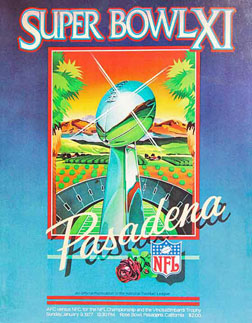
Rose Bowl before Super Bowl X
| # |
Player |
Pos. |
Hgt. |
Wgt. |
College |
Exp. |
| 8 |
Ray Guy |
P |
6-3 |
195 |
Southern Mississippi |
4 |
| 11 |
David Humm |
QB |
6-2 |
190 |
Nebraska |
2 |
| 12 |
Ken Stabler |
QB |
6-3 |
215 |
Alabama |
7 |
| 14 |
Errol Mann |
K |
6-0 |
200 |
North Dakota |
9 |
| 15 |
Mike Rae |
QB |
6-0 |
195 |
USC |
1 |
| 20 |
Neal Colzie |
CB |
6-2 |
200 |
Ohio State |
2 |
| 21 |
Cliff Branch |
WR |
5-11 |
170 |
Colorado |
5 |
| 24 |
Willie Brown |
CB |
6-1 |
210 |
Grambling State |
14 |
| 25 |
Fred Biletnikoff |
WR |
6-1 |
190 |
Florida State |
12 |
| 26 |
Skip Thomas |
CB |
6-1 |
205 |
USC |
5 |
| 28 |
Clarence Davis |
RB |
5-10 |
195 |
USC |
6 |
| 29 |
Hubert Ginn |
RB |
5-10 |
185 |
Florida A&M |
7 |
| 30 |
Mark van Eeghen |
RB |
6-2 |
225 |
Colgate |
3 |
| 31 |
Carl Garrett |
RB |
5-11 |
210 |
New Mexico Highlands |
8 |
| 32 |
Jack Tatum |
FS |
5-11 |
205 |
Ohio State |
6 |
| 36 |
Manfred Moore |
RB |
6-1 |
195 |
USC |
3 |
| 39 |
Willie Hall |
LB |
6-2 |
225 |
USC |
5 |
| 40 |
Pete Banaszak |
RB |
5-11 |
210 |
Miami (FL) |
11 |
| 41 |
Phil Villapiano |
LB |
6-2 |
225 |
Bowling Green |
6 |
| 43 |
George Atkinson |
SS |
6-0 |
180 |
Morris Brown |
9 |
| 46 |
Warren Bankston |
TE |
6-4 |
235 |
Tulane |
8 |
| 47 |
Charles Phillips |
S |
6-2 |
215 |
USC |
2 |
| 49 |
Mike Siani |
WR |
6-2 |
195 |
Villanova |
5 |
| 50 |
Dave Dalby |
C |
6-3 |
250 |
UCLA |
5 |
| 51 |
Rodrigo Barnes |
LB |
6-1 |
215 |
Rice |
4 |
| 52 |
Floyd Rice |
LB |
6-3 |
225 |
Alcorn State |
6 |
| 54 |
Rik Bonness |
LB |
6-3 |
220 |
Nebraska |
1 |
| 58 |
Monte Johnson |
LB |
6-5 |
240 |
Nebraska |
4 |
| 60 |
Otis Sistrunk |
DE |
6-3 |
275 |
None |
5 |
| 61 |
Herb McMath |
DE |
6-4 |
250 |
Morningside |
1 |
| 63 |
Gene Upshaw |
G |
6-5 |
255 |
Texas A&M-Kingsville |
10 |
| 64 |
George Buehler |
G |
6-2 |
270 |
Stanford |
8 |
| 66 |
Steve Sylvester |
G |
6-4 |
260 |
Notre Dame |
2 |
| 70 |
Henry Lawrence |
T |
6-4 |
270 |
Florida A&M |
3 |
| 72 |
John Matuszak |
DE |
6-7 |
270 |
Missouri, Tampa |
4 |
| 74 |
Dave Rowe |
DT |
6-7 |
270 |
Penn State |
10 |
| 75 |
John Vella |
T |
6-4 |
260 |
USC |
5 |
| 77 |
Charles Philyaw |
DE |
6-9 |
275 |
Texas Southern |
1 |
| 78 |
Art Shell |
T |
6-5 |
265 |
Maryland Eastern Shore |
9 |
| 79 |
Dan Medlin |
G |
6-3 |
260 |
North Carolina State |
3 |
| 81 |
Morris Bradshaw |
WR |
6-1 |
195 |
Ohio State |
3 |
| 83 |
Ted Hendricks |
LB |
6-7 |
220 |
Miami (FL) |
8 |
| 87 |
Dave Casper |
TE |
6-4 |
230 |
Notre Dame |
3 |
|
1976 Minnesota Vikings
| # |
Player |
Pos. |
Hgt. |
Wgt. |
College |
Exp. |
| 10 |
Fran Tarkenton |
QB |
6-0 |
190 |
Georgia |
16 |
| 12 |
Neil Clabo |
P |
6-2 |
200 |
Tennessee |
2 |
| 14 |
Fred Cox |
K |
5-11 |
200 |
Pittsburgh |
14 |
| 17 |
Bob Berry |
QB |
5-11 |
185 |
Oregon |
12 |
| 19 |
Bob Lee |
QB |
6-2 |
195 |
Arizona State, Pacific |
8 |
| 20 |
Bobby Bryant |
CB |
6-1 |
170 |
South Carolina |
9 |
| 22 |
Paul Krause |
FS |
6-3 |
200 |
Iowa |
13 |
| 23 |
Jeff Wright |
SS |
5-11 |
190 |
Minnesota |
6 |
| 25 |
Nate Allen |
CB |
5-10 |
170 |
Texas Southern |
6 |
| 26 |
Bob Grim |
WR |
6-0 |
200 |
Oregon State |
10 |
| 27 |
Autry Beamon |
S |
6-1 |
190 |
Texas A&M-Commerce |
2 |
| 28 |
Ahmad Rashad |
WR |
6-2 |
200 |
Oregon |
5 |
| 33 |
Brent McClanahan |
RB |
5-10 |
200 |
Arizona State |
4 |
| 35 |
Robert Miller |
RB |
5-11 |
205 |
Kansas |
2 |
| 40 |
Windlan Hall |
S |
5-11 |
180 |
Arizona State |
5 |
| 43 |
Nate Wright |
CB |
5-11 |
190 |
San Diego State |
8 |
| 44 |
Chuck Foreman |
RB |
6-2 |
205 |
Miami (FL) |
4 |
| 47 |
Ron Groce |
RB |
6-2 |
210 |
Macalester |
1 |
| 48 |
Sammy Johnson |
RB |
6-0 |
225 |
North Carolina |
3 |
| 50 |
Jeff Siemon |
LB |
6-3 |
235 |
Stanford |
5 |
| 53 |
Mick Tinglehoff |
C |
6-2 |
240 |
Nebraska |
15 |
| 54 |
Fred McNeill |
LB |
6-2 |
230 |
UCLA |
3 |
| 55 |
Amos Martin |
LB |
6-3 |
230 |
Louisville |
5 |
| 57 |
Doug Dumler |
C |
6-3 |
245 |
Nebraska |
4 |
| 58 |
Wally Hilgenberg |
LB |
6-3 |
230 |
Iowa |
13 |
| 59 |
Matt Blair |
LB |
6-5 |
230 |
Iowa State |
3 |
| 60 |
Roy Winston |
LB |
5-11 |
220 |
LSU |
15 |
| 62 |
Ed White |
G |
6-2 |
270 |
California |
8 |
| 68 |
Charles Goodrum |
G |
6-3 |
255 |
Florida A&M |
4 |
| 69 |
Doug Sutherland |
DT |
6-3 |
250 |
Wisconsin-Superior |
7 |
| 70 |
Jim Marshall |
DE |
6-4 |
230 |
Ohio State |
17 |
| 72 |
James White |
DT |
6-3 |
265 |
Oklahoma State |
1 |
| 73 |
Ron Yary |
T |
6-5 |
255 |
USC |
9 |
| 74 |
Bart Buetow |
T |
6-5 |
250 |
Minnesota |
4 |
| 77 |
Mark Mullaney |
DE |
6-6 |
240 |
Colorado State |
2 |
| 78 |
Steve Riley |
T |
6-5 |
260 |
USC |
3 |
| 80 |
Leonard Willis |
WR |
5-11 |
185 |
Ohio State |
1 |
| 81 |
Carl Eller |
DE |
6-6 |
245 |
Minnesota |
13 |
| 83 |
Stu Voigt |
TE |
6-1 |
225 |
Wisconsin |
7 |
| 84 |
Steve Craig |
TE |
6-3 |
230 |
Northwestern |
3 |
| 85 |
Sammy White |
WR |
5-11 |
190 |
Grambling State |
1 |
| 88 |
Alan Page |
DT |
6-4 |
245 |
Notre Dame |
10 |
|
References: Hey, Wait a Minute, I wrote a book! John Madden with Dave Anderson (1984)
Snake: The On-and-Off-the-Field Exploits of Football's Wildest Renegade, Ken Stabler and Barry Stainback (1986)
Black Knight: Al Davis and His Raiders, Ira Simmons (1990)
The Super Bowl: Celebrating a Quarter-Century of America's Greatest Game (1990)
Super Bowl Chronicles: A Sportswriter Reflects on the First 30 Years of America's Game, Jerry Green (1995)
They Call Me Assassin, Jack Tatum with Bill Kushner (1996)
Super Bowl: The Game of Their Lives, Danny Peary (ed.) (1997)
Stadium Stories: Oakland Raiders, Colorful Tales of the Silver and Black, Tom LaMarre (2003)
The Football Game I'll Never Forget: 100 NFL Stars' Stories, selected by Chris McDonell (2004)
The Ultimate Super Bowl Book, Bob McGinn (2009)
Badasses: The Legend of Snake, Foo, Dr. Death, and John Madden's Oakland Raiders, Peter Richmond (2010)
The Last Headbangers: NFL Football in the Rowdy, Reckless '70s, Kevin Cooke (2012)
50 Years, 50 Moments: The Most Unforgettable Plays in Super Bowl History, Jerry Rice and Randy O. Williams (2015)
Super Bowl Gold: 50 Years of the Big Game, Sports Illustrated (2015)
The Super Bowl: The First Fifty Years of America's Greatest Game, David Fischer (2015)
The NFL in the 1970s: Pro Football's Most Important Decade, Joe Zagorski (2016)
The First 50 Super Bowls: How Football's Championships Were Won, Ed Benkin (2018)
|
|





























